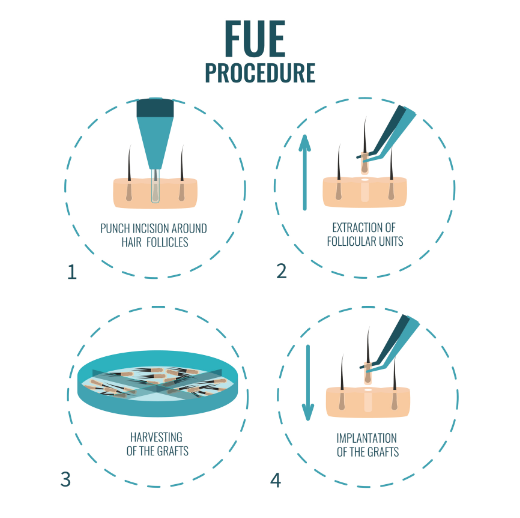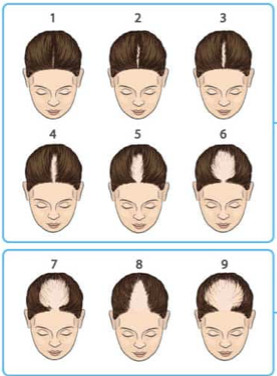By John C. Anderson Ph.D.

Introduction
One day you wake up and realize that your hair has disappeared. Well, no everywhere but whether it is a receding hairline or a growing bald spot on the crown or your head, you are seeing more skin that hair. What do you do? Historically, for many men and women, the first alternative was disguise – comb your hair in a way that minimizes the amount of visibility of the amount of thinning or baldness. Few will remember Ron Popeil’s (the king of TV inventions and infomercials) Hair Formula #9 – hair in a spray can. The next choice often involved weaves, wigs or toupees for complete coverage. Unfortunately, this alternative rarely looked natural.
Hair transplants became more popular in the 1980s. However, the first phase of this trend involved the transplantation of hair plugs (many follicles in a group like a shrub) in rows on the patient’s head. It was a painful procedure that announced to the world exactly what you were doing. Over time, this process became much more refined but still involved the excision of a strip of hair from the back of the patient’s head. The incision was then stitched closed leaving a significant scar that was visible (especially when swimming) and needed to be covered by the hair that was left.
Follicular Unit Extraction (FUE)
The hair replacement field changed dramatically with the development of FUE. With this procedure, individual follicles are harvested from the back of the head – the area in which hair tends to remain the thickest and healthiest even when losing hair elsewhere. The follicles that are extracted are then individually transplanted into the area of the head targeted for hair replacement. A single follicle may contain a number of individual hairs attached to it.
The procedure involves a careful diagnosis of the current need for hair replacement using the Savin scale (see Figure below). The areas in need of transplant are identified along with the number of follicles that will be needed to obtained the desired coverage. A technician then harvests the areas from the safe area (immune from DHT) in the back of the head and transplants them into the target area on the crown, top of the head or eyebrows.
While there are a number of different FUE devices (e.g. NetGraft, Artus, SmartGraft), Capily Institute recommends the SmartGraft device and procedure as it produces follicles with higher viability for the transplant. Why is this the case? The SmartGraft device allows all follicles to be collected, counted, stored in a sterile temperature-controlled and hydrated environment.
As each follicle is individually extracted it is sent through a tube where it is cleaned and kept in a climate-controlled environment to maintain hydration and viability while waiting to be transplanted. As it can take a few hours for the individual follicles to be harvested, depending on the extensiveness of the transplant procedure, other devices may allow the follicles to dry out, reducing their viability.

After the desired amount of hair has been harvested, the transplant recipient area is then locally anesthetized. This is the area that you and the Hair Transplant Expert Team had marked together at the very beginning. One hair follicle at a time is transplanted using the device.
It first creates holes for the donor follicles. A scalpel isn’t needed for this step. The hairs are then inserted into these holes. The system ensures the hairs will be placed at the right depth and the correct natural angle. Your transplantation procedure will take around five to six hours. You will go home thereafter and may return to normal social life after 2 days.
When Will The Hair Start To Grow On Its Own?
Your transplanted hair is very likely to fall out soon after the treatment over the next two to three weeks. This can be discouraging, but it is totally natural. This doesn’t mean transplantation failed; it simply is a reaction to the trauma of transplantation. The follicles that survive (usually around 90 percent) will then fully take and will return to the anagen (growth) phase in 3-4 months. As the anagen cycle continues, hair will grow naturally through these transplanted follicles.
Will My Hair Look Natural After Transplantation?
Fully functioning hair follicles are transplanted to your balding areas. As mentioned earlier, these occipital follicles are not susceptible to the reasons that caused your balding, so they will grow hair normally which will be your natural scalp hair. This new hair will thus be immune to future balding.
The Hair Transplant Team achieves the most natural results by ensuring to place the angle of the implanted hair in a natural way for each particular area and also taking care to follow the pattern of a natural hairline.
Recovery After SmartGraft Transplantation
Recovery is easy. There might be mild discomfort around the donor or recipient sites, and occasionally patients take a regular Tylenol for it. Both the donor sites and the transplant sites heal quickly and most people go back to work between 1 – 3 days
You may wash your hair in three days after your procedure. We’ll show you how to wash the transplanted area with water to keep the recipient area clean and to stop it from developing crusts on the implanted follicles; it’s important not to rub the follicles and not to use a towel to dry the area. And…. you are on your way to new youthful hair!
Understanding the causes of your particular hair loss and identifying the stage of hair loss is very important in developing a treatment plan that can range from addressing the underlying cause (medical or hormonal) to topical or surgical alternatives. The doctors associated with the Capily Institute can help diagnose and treat all forms of hair loss, recommending the best strategy for hair restoration or replacement.















